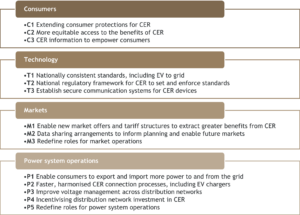Shirley Cheng, Aaron Brooks and Miranda Hutchesson look at Australia’s groundbreaking national plan to harness the power of consumers – literally.
The fundamental role the customer will play in Australia’s energy transition is becoming increasingly paramount, with consumers being dubbed the potential saviours on the road to decarbonisation.
In July 2024, Australian energy ministers unveiled the National Consumer Energy Resources Roadmap (Roadmap), a blueprint for the integration of Consumer Energy Resources (CER) into the national grid. The Roadmap details a reform program built around four workstreams – Consumers, Technology, Markets and Power System Operations, aiming to modernise the energy system while ensuring equitable and sustainable outcomes.
If effectively leveraged through the right policy and regulatory settings, CER hold the potential to offset the need for billions of dollars of investment in the grid, lowering costs for all Australians. The Roadmap aims to empower everyday Australians to play a part in the energy transition and to take direct responsibility for and control of their energy requirements.
The rapid adoption of CER – especially via rooftop solar
“Australian consumers are driving one of the fastest transformations of electricity systems in the world through record breaking investment in CER.” – Roadmap, p4
CER are resources owned by individual consumers that can generate and store electricity, or can manage and alter consumer demand. These technologies include rooftop solar, household batteries, electric vehicles (EVs) and any other behind-the-meter consumer owned or operated resource that can produce and store energy and be flexible about its usage. They produce invaluable data points that have the ability to safeguard our electricity grid, such as predictive analytics and real-life monitoring of energy usage.
Recent reports confirm that one third of Australian households have installed rooftop solar.[1] Collectively, these systems surpass the capacity of the largest single generator in the National Electricity Market (NEM), representing about 11.2% of Australia’s total energy generation capacity.[2] However, the rapid expansion of CER extends beyond solar panels, with expectations for small-scale battery capacity to grow from 1 GW to 6.6 GW within the NEM by 2029-2030. Additionally, forecasts suggest there will be 1.5 million EVs on Australia’s roads by 2030.[3]
Successful integration of CER could be the linchpin in the energy transition, benefitting both:
- Consumers – through reducing energy bills, wholesale energy prices and network costs, and
- The grid – through stabilising the grid and reducing the need for investment in large scale generation and storage capacity.
Despite the clear advantages of CER, at the 2023 Energy & Climate Summit Australian Energy Market Commission (AEMC) chairwoman Anna Collyer (who joins us to discuss this topic and more at our Digital Future Summit – register here to watch) reflected that CER “isn’t getting the attention it deserves.” Galvanising Australia’s energy ministers, Ms Collyer noted that more work needs to be done before we are able to fully reap the benefits of CER.
Rethinking a legacy power network designed for consumers – not their power
Perhaps the most significant challenge that CER pose to policymakers and regulators is the fact that the National Electricity Market (NEM) was originally designed to cater to consumers, rather than to be influenced by them. To successfully incorporate CER into the NEM, we must rethink the conventional energy supply chain and the structure of the power grid.
Traditionally, the grid has operated as a centralised system, with electricity flowing in one direction: from the producers to the consumers. This one-way energy supply chain typically involves large-scale power plants – once dominated by coal, but now increasingly by wind and solar farms – generating electricity and sending it through high-voltage transmission lines and local distribution networks to reach the end-users.
However, with the ongoing deployment of CER, the existing grid must be adapted to support a two-way flow of electricity. In this emerging model, power generation is distributed, with a considerable amount of electricity produced on a smaller scale. This shift allows consumers to actively participate in the wholesale NEM, contributing to a more dynamic and interactive energy landscape.

A step in the right direction: the Roadmap priorities
Instead of perceiving CER and a decentralised grid as challenges to surmount, policymakers are recognising CER as valuable assets to be harnessed and as a strategic component of our energy strategy. In line with the rapid uptake in CER and Ms Collyer’s call to action, on 19 July 2024, state and federal energy ministers endorsed the Roadmap crafted by the interjurisdictional CER Working Group. The Roadmap sets out a cohesive national vision and strategy to reform the energy system to successfully integrate CER.
The Roadmap’s implementation plan is organised into four main workstreams, each with its own set of national reform priorities:

Each workstream has the task of advancing reform initiatives that focus on enhancing technical standards, consumer incentives and consumer safeguards. The Roadmap recognises that these initiatives are interconnected and will require collaboration across multiple industry stakeholders, such as the CER Taskforce, CER Working Group, the Australian Energy Market Commission (AEMC), the Australian Energy Regulator (AER) and the Australian Energy Market Operator (AEMO).
What’s next in the world of CER?
Although the Roadmap marks a positive move towards a cohesive approach to managing and regulating CER, there’s considerable work ahead to unlock the full potential of CER. The next few years will prove critical as regulators and policymakers continue to explore optimal ways to utilise CER for more considered, effective, and unified energy demand management.
With consumers playing an increasingly pivotal role in the shift towards sustainable energy, our team at KWM will maintain vigilant oversight of the evolving landscape. A number of promising initiatives are on the immediate horizon, signalling an exciting phase of development, including:
- the AEMC’s review of “electricity pricing for a consumer-driven future” to help drive CER to deliver net benefits of up to $6.3 billion by 2040
- the NSW Government’s development of a new consumer energy strategy, for release in 2024, and
- the AEMO and AusNet co-design of a national CER data exchange to enhance visibility and data-sharing relating to CER.
Interested in learning more about CER, hearing from industry experts such as Anna Collyer, or getting key insights directly from KWM’s energy and technology experts? Join us at the upcoming KWM Digital Future Summit (21, 22, 27 & 28 August).
Our Summit brings together a stellar lineup of industry leaders and experts to help you make sense of the digital transformation and the regulatory landscape governing data and emerging tech. We also throw a spotlight on how innovation and technology can help accelerate and address energy transition for a more sustainable future.
[1] Energy and Climate Change Ministerial Council (2024) National Consumer Energy Resources Roadmap: Powering Decarbonised Homes and Communities, accessed 9 August 2024, p.6.
[2] Clean Energy Council (2023) Rooftop solar and storage report H2 2023, accessed 9 August 2024.
[3] AEMO (Australian Energy Market Operator) (2024) 2024 Integrated System Plan, accessed 9 August 2024; Electric Vehicle Council (2022) Home EV charging and the grid: impact to 2030 in Australia, accessed 9 August 2024.






